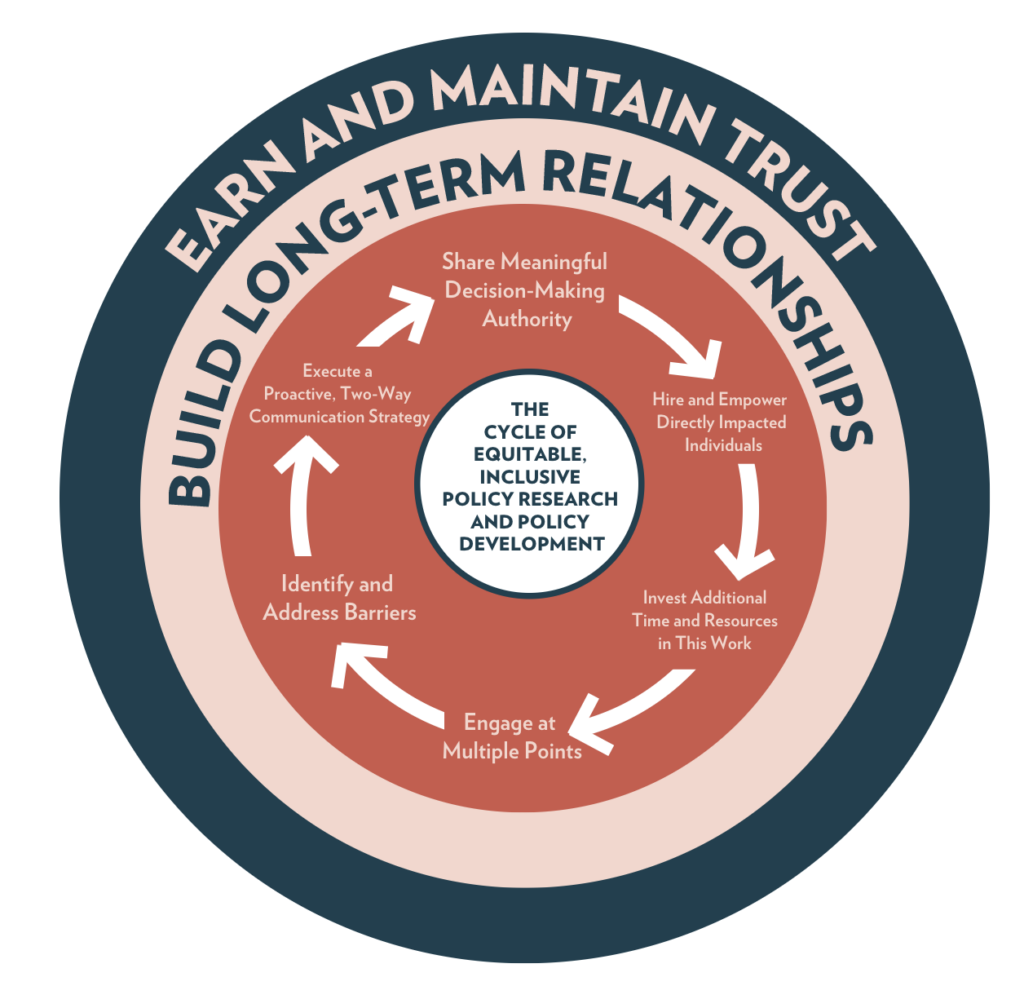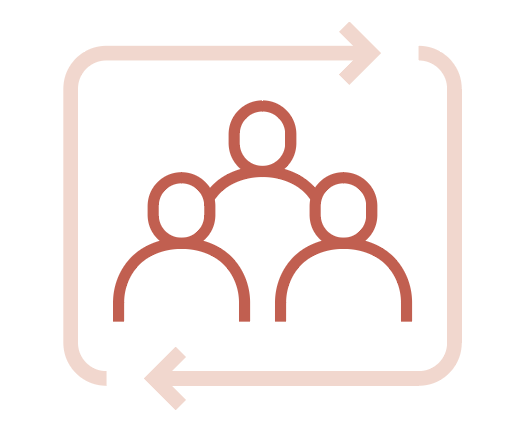Inclusive Policy Research and Policy Development with Impacted Communities: Summary of Recommendations
This a brief summary of the recommendations included in the inclusive policy toolkit that identify the best practices for public policy organizations and government agencies or offices doing policy work with impacted communities.
Our nation has a long history of excluding individuals and communities from the policymaking table—because of their race, ethnicity, or immigration status; their age, income, or educational level; or any number of other factors—even though they are often those who are most affected by our policy choices. Nowhere is the exclusion of directly impacted communities more indefensible than in our democracy and policymaking process, the precise forums where decisions are made about how to prioritize, develop, and implement the solutions to our collective problems. For policy leaders who want to develop, influence, enact, and implement public policies to build a more just society, eliminating this systemic exclusion is critical.
This toolkit identifies and shares best practices on how public policy organizations, including government agencies or offices, can engage directly impacted communities and individuals in policy research and policy development with an aim toward true inclusion, collaboration, empowerment, and equity. Below is a brief summary of the recommendations included in the toolkit. For additional context on each recommendation, please see the full toolkit here.

 1. Earn and maintain trust with directly impacted communities and individuals.
1. Earn and maintain trust with directly impacted communities and individuals.
Trust, while difficult to establish, is the foundational structure that will help policy sector organizations build and sustain long-term relationships with impacted communities and individuals that empowers them to engage honestly and productively in policy work. It’s a necessary—but not sufficient—building block that is critical to each additional recommendation in this toolkit. Building trust is not easy, especially at first. Policy sector organizations can establish trust by demonstrating respect for the expertise of impacted communities, being transparent and forthright with communication, and avoiding transactional or tokenizing interactions.
 2. Identify and build long-term relationships with the individuals and communities who should be engaged in policy research and policy development.
2. Identify and build long-term relationships with the individuals and communities who should be engaged in policy research and policy development.
Proactively identify which individuals and/or communities should be an ongoing part of policy research and policy development and engage with those individuals and/or communities, ideally for long-term collaboration and partnership across multiple projects and goals.
- Strategy 1. Identify which individuals and/or communities need to be at the table to build an inclusive policy or research project.
- Strategy 2. Engage and build long-term relationships with directly impacted individuals and the community based organizations (CBOs) that have trusted relationships with, and are proximate to, directly impacted communities.
- Strategy 3. Recognize that communities are complex and include a diversity of individuals, perspectives, and opinions; no one should be asked to speak for an entire community.
 3. Share meaningful decision-making authority.
3. Share meaningful decision-making authority.
Identify opportunities to collaborate with and empower directly impacted individuals and communities by sharing authority over direction and decisions at various stages in policy research and policy development.
- Strategy 1. Identify the scope and degree of community influence and input and ensure that directly impacted communities are exercising the decision-making authority that aligns with those goals.
- Strategy 2. For large projects and formal partnerships, co-develop a structure for the partnership between policy sector organizations and directly impacted communities, including an oversight committee with decision-making authority to ensure an equitable distribution of power.
4. Recruit, hire, equip, and empower directly impacted individuals to lead policy work.
Ensure that your organization employs directly impacted individuals in full-time roles and as contractors to lead policy research and policy development.
- Strategy 1. Hire directly impacted individuals for full-time roles within the policy sector.
- Strategy 2. Hire contractors—such as advisors, contributors, facilitators, and organizers—from directly impacted communities.
 5. Allocate the additional time and resources necessary to engage with impacted communities and value their experiences and participation.
5. Allocate the additional time and resources necessary to engage with impacted communities and value their experiences and participation.
Invest the time, the funds, and in the people—including directly impacted communities themselves—that are necessary for equitable and inclusive engagement and empowerment.
- Strategy 1. Build in time for an equitable and inclusive process.
- Strategy 2. Budget and fundraise to effectively partner with directly impacted communities, and ensure those communities’ time and expertise is valued.
- Strategy 3. Pay people fairly for their time, insights, and expertise.
 6. Engage with directly impacted individuals and communities at multiple points in the process, and beyond.
6. Engage with directly impacted individuals and communities at multiple points in the process, and beyond.
Directly impacted individuals should be engaged at the start of, and throughout, the policy research and policy development process.
- Strategy 1. Include directly impacted communities at the beginning of the process.
- Strategy 2. Continue to engage directly impacted communities throughout the entirety of the policy research and policy development process.
 7. Identify and address barriers to participation for impacted individuals.
7. Identify and address barriers to participation for impacted individuals.
Proactively identify the practical and strategic challenges that impede participation by directly impacted individuals and engage individuals impacted by those challenges to solve for them.
- Strategy 1. Anticipate common practical barriers to participation, such as transportation and technological barriers, and have a plan to address them.
- Strategy 2. Anticipate common strategic challenges, such as a lack of trust for government, and have a plan to address them.
- Strategy 3. Stay aware of emerging practical and strategic challenges.
 8. Leverage a proactive, two-way communication strategy at each stage of the process and in multiple languages and modalities.
8. Leverage a proactive, two-way communication strategy at each stage of the process and in multiple languages and modalities.
Practice active listening, provide opportunities for gathering input and sharing feedback, and deliver key messages as early as possible using language and modalities that are accessible to everyone.
- Strategy 1. Hold regular sessions with directly impacted communities, that are based on active listening and proactive, transparent two-way communications.
- Strategy 2. Use formal and informal methods to gather input, receive feedback, and learn from directly impacted communities.
- Strategy 3. Manage expectations by clearly communicating the goals and limitations of the project, and the scope of participation.
- Strategy 4. Seek informed consent from partners.

